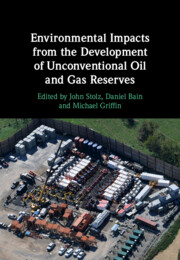Book contents
- Environmental Impacts from the Development of Unconventional Oil and Gas Reserves
- Environmental Impacts from the Development of Unconventional Oil and Gas Reserves
- Copyright page
- Contents
- Figures
- Tables
- Contributors
- Preface
- Part I Overview
- Part II Environmental Analysis
- Part III Case Studies
- 13 Evaluation of Potential Water Quality Impacts in Unconventional Oil and Gas Extraction
- 14 A Baseline Ecological Study of Tributaries in the Tenmile Creek Watershed, Southwest Pennsylvania
- 15 The Effects of Shale Gas Development on Forest Landscapes and Ecosystems in the Appalachian Basin
- 16 Managing TDS and Sulfate in the Monongahela River
- Index
- References
14 - A Baseline Ecological Study of Tributaries in the Tenmile Creek Watershed, Southwest Pennsylvania
from Part III - Case Studies
Published online by Cambridge University Press: 28 July 2022
- Environmental Impacts from the Development of Unconventional Oil and Gas Reserves
- Environmental Impacts from the Development of Unconventional Oil and Gas Reserves
- Copyright page
- Contents
- Figures
- Tables
- Contributors
- Preface
- Part I Overview
- Part II Environmental Analysis
- Part III Case Studies
- 13 Evaluation of Potential Water Quality Impacts in Unconventional Oil and Gas Extraction
- 14 A Baseline Ecological Study of Tributaries in the Tenmile Creek Watershed, Southwest Pennsylvania
- 15 The Effects of Shale Gas Development on Forest Landscapes and Ecosystems in the Appalachian Basin
- 16 Managing TDS and Sulfate in the Monongahela River
- Index
- References
Summary
In efforts to understand the potential impacts of the Marcellus Shale extraction activities on stream health, we performed a baseline study on a focal pair of small streams in the Tenmile Creek watershed in Greene County, Pennsylvania. Bates Fork had intensive Marcellus Shale well drilling activity and several violations upstream from our study site. A tributary, Fonner Run, served as a control stream site with no drilling activity. Through two years of monitoring, we established baselines for water chemistry and biological communities of bacteria, fish and salamanders. In addition, we compared population genetic diversity of two darter species with microsatellite markers. Although no conclusive differences were found between the stream-pair, we established baseline parameters and gained insight into refining tools to detect the signature of Marcellus Shale extraction impacts on small streams in southwestern Pennsylvania. We conclude this chapter with lessons learned from this case study, future directions and suggestions for improved monitoring and detection of Marcellus Shale impacts on streams in southwestern Pennsylvania.
- Type
- Chapter
- Information
- Publisher: Cambridge University PressPrint publication year: 2022



